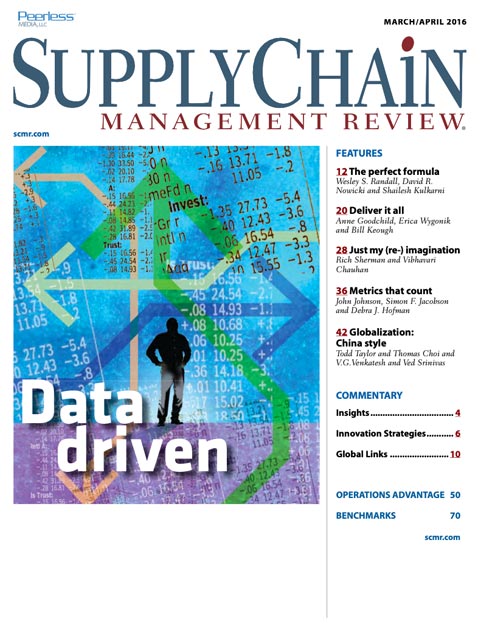Sorry, but your login has failed. Please recheck your login information and resubmit. If your subscription has expired, renew here.
March-April 2016
When I visit my millennial-aged daughter in Chicago, I’m amazed at the number of packages dropped off by UPS, FedEx and the USPS at her three-unit building on a daily basis. It’s as if she and her neighbors are single-handedly keeping Amazon in business. All those drop-offs got me to wondering: Does any of this make sense if you think about a carbon footprint? Rather than deliver millions of packages to one address at a time every day, wouldn’t it be more sustainable if we all just drove to the mall to do our shopping? After all, doesn’t research indicate that a signi cant percentage of consumers, especially millennial consumers like my… Browse this issue archive.Need Help? Contact customer service 847-559-7581 More options
China rose from an underdeveloped backwater to an industrial juggernaut on the strength of its vast pool of low-wage workers. Labor cost advantages enabled Chinese manufacturers to take over industries ranging from consumer electronics to machine tools. But cracks have begun to appear in this model. China’s official manufacturing purchasing-managers index (PMI) fell to a three-year low last summer, dropping into contraction territory for the first time in six months. The stock market tumble earlier this year seemed to indicate further disarray.
Behind the numbers are indeed signs that China’s cost advantages are starting to slip. While wages in China remain well below those of western countries, manufacturers find far lower labor costs in Vietnam, Myanmar, Indonesia, Bangladesh, and even India. At the same time, high staff turnover undermines productivity in Chinese factories. In high-tech for example, many original device manufacturers (ODMs) suffer turnover rates of 15% to 20% per month. High turnover reflects a tightening labor supply in a country where demographics favored employers for the past several decades. That is changing, with the number of available workers expected to fall from a peak of 915 million today to 890 million in 2025.
Bloated cost structures and inefficient manufacturing processes take another bite out of productivity. Chinese manufacturers are up to 70% less efficient than Western counterparts in indirect functions such as materials handling and quality assurance. Raw materials conversion rates also lag global norms: A Chinese steelmaker uses three times as much water and twice as much energy to produce a ton of steel than more efficient manufacturers in Germany.
 |
This complete article is available to subscribers
only. Click on Log In Now at the top of this article for full access. Or, Start your PLUS+ subscription for instant access. |
SC
MR
Sorry, but your login has failed. Please recheck your login information and resubmit. If your subscription has expired, renew here.
March-April 2016
When I visit my millennial-aged daughter in Chicago, I’m amazed at the number of packages dropped off by UPS, FedEx and the USPS at her three-unit building on a daily basis. It’s as if she and her neighbors are… Browse this issue archive. Access your online digital edition. Download a PDF file of the March-April 2016 issue.
 |
Download Article PDF |
China rose from an underdeveloped backwater to an industrial juggernaut on the strength of its vast pool of low-wage workers. Labor cost advantages enabled Chinese manufacturers to take over industries ranging from consumer electronics to machine tools. But cracks have begun to appear in this model. China's official manufacturing purchasing-managers index (PMI) fell to a three-year low last summer, dropping into contraction territory for the first time in six months. The stock market tumble earlier this year seemed to indicate further disarray.
Behind the numbers are indeed signs that China's cost advantages are starting to slip. While wages in China remain well below those of western countries, manufacturers find far lower labor costs in Vietnam, Myanmar, Indonesia, Bangladesh, and even India. At the same time, high staff turnover undermines productivity in Chinese factories. In high-tech for example, many original device manufacturers (ODMs) suffer turnover rates of 15% to 20% per month. High turnover reflects a tightening labor supply in a country where demographics favored employers for the past several decades. That is changing, with the number of available workers expected to fall from a peak of 915 million today to 890 million in 2025.
Bloated cost structures and inefficient manufacturing processes take another bite out of productivity. Chinese manufacturers are up to 70% less efficient than Western counterparts in indirect functions such as materials handling and quality assurance. Raw materials conversion rates also lag global norms: A Chinese steelmaker uses three times as much water and twice as much energy to produce a ton of steel than more efficient manufacturers in Germany.
 |
SUBSCRIBERS: Click here to download PDF of the full article. |
SC
MR

Latest Supply Chain News
- Technology’s role in mending supply chain fragility after recent disruptions
- Tech investments bring revenue increases, survey finds
- Survey reveals strategies for addressing supply chain, logistics labor shortages
- Israel, Ukraine aid package to increase pressure on aerospace and defense supply chains
- How CPG brands can deliver on supplier diversity promises
- More News
Latest Podcast

 Explore
Explore
Topics
Latest Supply Chain News
- Technology’s role in mending supply chain fragility after recent disruptions
- Tech investments bring revenue increases, survey finds
- Survey reveals strategies for addressing supply chain, logistics labor shortages
- Israel, Ukraine aid package to increase pressure on aerospace and defense supply chains
- How CPG brands can deliver on supplier diversity promises
- How S&OP provides the answer to in-demand products
- More latest news
Latest Resources

Subscribe

Supply Chain Management Review delivers the best industry content.

Editors’ Picks





